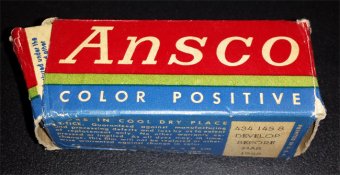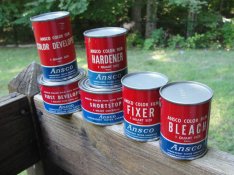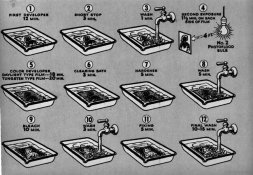typicalaussiebloke
Member
- Joined
- May 30, 2014
- Messages
- 49
- Format
- Medium Format
G'day all.
I have a few rolls of Ansco Color Positive films from the 40s and 50s and have shot a 120 roll from 1955 about a month ago. I have been cutting samples and attempted cross processing in C-41 but got clear base. However I then saw on Ebay an old unopened Ansco Color developing kit made from around that time selling cheap so I bought it. I understand that chemicals go off after a period of time but I have seen some people on Flickr using 100 year old developing powders as an experiment and they worked fine for their films, I may be right or wrong here but I guess in powdered form developers last longer? This Ansco kit is in powdered form in sealed cans so perhaps it might possibly still work.
I intend to have a go at developing that Ansco Color film in it and hope for the best, only main thing stopping me is the re-exposure to lamp part of the process as I am unsure whether to re-expose the film for a longer period of time and perhaps at closer range from the bulb given the loss of sensitivity of the film being nearly 60 years old, and I am uncertain whether I can just leave the film inside the Paterson reel during re-exposure or not as rolling the film back onto the reel while wet it might stick and not go back on properly. I admit I've not yet done reversal developing before so need some advice with this procedure. As for the No.2 photoflood bulb, I guess I can find some on Ebay but is there an easy available alternative?
I aim to at least get a picture on this film even if colours don't form properly, as long as I get something usable that will be good enough.
Below are pics of the developer kit, the developing instructions from a late 40s magazine and the film I intend to develop.
I have a few rolls of Ansco Color Positive films from the 40s and 50s and have shot a 120 roll from 1955 about a month ago. I have been cutting samples and attempted cross processing in C-41 but got clear base. However I then saw on Ebay an old unopened Ansco Color developing kit made from around that time selling cheap so I bought it. I understand that chemicals go off after a period of time but I have seen some people on Flickr using 100 year old developing powders as an experiment and they worked fine for their films, I may be right or wrong here but I guess in powdered form developers last longer? This Ansco kit is in powdered form in sealed cans so perhaps it might possibly still work.
I intend to have a go at developing that Ansco Color film in it and hope for the best, only main thing stopping me is the re-exposure to lamp part of the process as I am unsure whether to re-expose the film for a longer period of time and perhaps at closer range from the bulb given the loss of sensitivity of the film being nearly 60 years old, and I am uncertain whether I can just leave the film inside the Paterson reel during re-exposure or not as rolling the film back onto the reel while wet it might stick and not go back on properly. I admit I've not yet done reversal developing before so need some advice with this procedure. As for the No.2 photoflood bulb, I guess I can find some on Ebay but is there an easy available alternative?
I aim to at least get a picture on this film even if colours don't form properly, as long as I get something usable that will be good enough.
Below are pics of the developer kit, the developing instructions from a late 40s magazine and the film I intend to develop.













